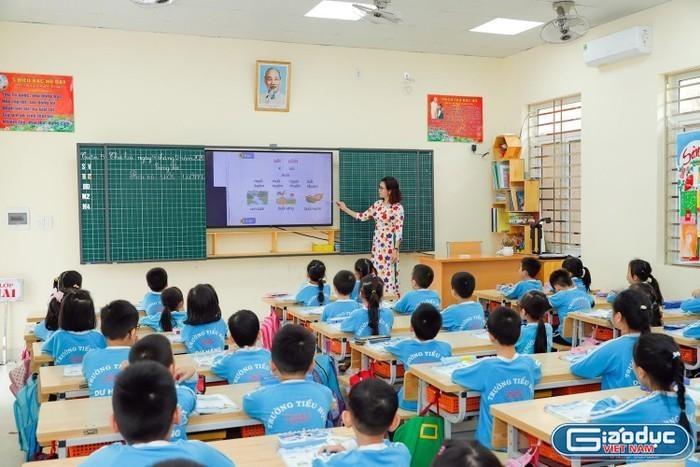In the guiding documents of the Ministry of Education and Training on professional activities, the two concepts of “test” and “exam” are completely different in nature. But there are still educational managers and teachers who confuse these two concepts, leading to confusion in direction, work implementation and application of policies.
- Ocean Edu tổ chức chuỗi hội thảo “Cùng con hạnh phúc – Thấu hiểu và đồng hành”
- Học phí ngành Quản trị dịch vụ du lịch và lữ hành từ 18 – 60 triệu đồng/năm
- GV đánh giá đề tham khảo Ngữ văn dẹp học “tủ”, đề Sử có “thách” nhưng không “đố”
- GV có nhiều áp lực, cho phép dạy thêm thầy cô lấy đâu thời gian nghỉ ngơi?
- Trường Phổ thông Quốc tế Việt Nam công khai đội ngũ giáo viên chỉ bằng 1 bức ảnh
The word “test” is only used to evaluate and classify students within classes and schools
Bạn đang xem: Đừng máy móc áp đề kiểm tra định kỳ giống cấu trúc, định dạng đề thi tốt nghiệp
The writer would like to review a number of circulars over the past 10 years regulating the assessment and grading of students so that readers can have a comprehensive perspective.
Firstly, Circular 58/2011/TT-BGDĐT of the Ministry of Education and Training promulgating Regulations on evaluation and grading of middle school and high school students, stipulates: “Form test format, types of tests, test score coefficients” (Article 7), “Number of tests and scoring methods” (Article 8), “Testing and scoring of elective and core subjects” Elective topics from subjects” (Article 9).
Second, Circular 26/2020/TT-BGDĐT amends and supplements a number of articles of the Regulation on evaluation and grading of middle school and high school students issued together with Circular No. 58/ 2011/TT-BGDDT dated December 12, 2011 of the Minister of Education and Training, replacing some phrases as follows:
The phrase “Forms of inspection” (Clause 1, Article 7, Circular 58) is replaced with the phrase “Types of inspection and assessment” (Clause 1, Article 7, Circular 26).
The phrases “Regular inspection”, “Periodic inspection” (points a, b, Article 7, Circular 58) are changed to “Regular inspection and assessment”, “Periodic inspection and assessment” ( Points a, b, Article 7, Circular 26).
Third, Circular No. 22/2021/TT-BGDDT regulating the assessment of middle school and high school students uses the phrase “Test and assessment”:
“For a subject, each student is tested and evaluated many times, in which a number of times of testing and evaluation is selected in accordance with the teaching process according to the educational plan of the professional team, and the results are recorded. evaluated in the Student Monitoring and Evaluation Book (by class) for use in evaluating subject learning outcomes according to regulations” (Clause 2, Article 6. Regular evaluation).
“Periodical assessment (not done for learning topics), including mid-term assessment and final assessment, is done through: tests (on paper or on computer), practice exercises , learning project” (clause 1, Article 7. Periodic assessment).

Illustration photo: La Tien
The above Circulars all use the word “test” and not the word “examination”. Thereby, it can be roughly understood as follows: “Tests” are students' products and assignments (diverse forms) directly taught by teachers, set questions (requirements), and self-organized in class. taught (regular testing) or centrally organized by the school (periodic testing).
The purpose of testing is to use test results as a basis for teachers to evaluate students' training and learning that take place during the implementation of teaching activities or after a period in the school year as required. meet the regulations in the General Education Program.
Thus, in professional teaching and learning activities in high schools, there is no concept of “exam” but only the concept of “test”. Broadly understood, teachers and schools only have the function of organizing “tests” such as: checking old lessons, 15-minute tests, oral tests, 1-period tests, mid-term tests, final tests, …
Competition activities in school such as Art Competitions, Sports Competitions, Cooking Competitions,… are movement activities, not professional activities.
Therefore, teachers – those directly working in the education sector – need to correctly call the word “test” in the school's professional activities, avoiding habitual confusion such as: “semester exam”, “semester exam”, “semester exam”, “semester exam marking”,…
The word “exam” is often used at the Department and Ministry level
Firstly, in the Education Law (2019), in Clause 3, Article 34, it is stipulated: “Students who have completed the high school program and meet the conditions according to the regulations of the Minister of Education and Training can take the exam. If you meet the requirements, you will be awarded a high school diploma by the head of the specialized education agency under the Provincial People's Committee.
Second, according to the draft Circular promulgating the Regulations on middle school enrollment and high school enrollment in 2025, there is a regulation: “Organization of entrance exams” (Article 12) including: “Exam subjects” (clause 1), “Giving exam questions” (clause 2), “Observing exams” (clause 3), “Marking exams” (clause 4), “Reviewing exams” (clause 5).
Third, the draft Circular promulgating high school graduation exam regulations from 2015, has regulations: “Exam regulations”; “Exam Council”; “Exam subject”….
Xem thêm : Nhiều học sinh giờ ra chơi “dính” vào điện thoại, ít tương tác giao lưu bạn bè
According to regulations of the Ministry of Education and Training, middle schools and high schools do not have the function of organizing entrance exams at the beginning of the level.

The Department of Education and Training is responsible for organizing the 10th grade entrance exam, from establishing the exam council, marking the exam to announcing the results.
The high school graduation exam is organized and responsible by the National Exam Steering Committee (Ministry of Education and Training) and the Provincial Exam Steering Committee.
The purpose of the 10th grade entrance exam is to classify students in the direction of continuing high school education or vocational training. In addition, there is also a need to study more than places to study and the quality between educational institutions is not the same. evenly.
The purpose of the high school graduation exam is to evaluate the learning outcomes of learners according to the goals and requirements of the program, to recognize high school graduation, and as a basis for evaluating the quality of teaching. of educational institutions and used for university admissions.
Thus, the school has the function of organizing multiple tests on the same students throughout the school level periodically to evaluate the quality of students' learning in each stage, from which to propose educational measures. Reasonable education in the future in a way that helps students progress; The Department of Education and Training will organize entrance exams for grade 10; The Ministry of Education and Training organizes the high school graduation exam.
Test questions do not necessarily have the same structure and format
Firstly, Circular No. 22/2021/TT-BGDDT stipulates assessment based on the requirements to be met of the Program; ensure accuracy, fairness, honesty and objectivity. To do so, exam questions must choose materials other than current textbooks.
Currently, Literature has 3 sets of books used to teach in high schools: Kite, Connecting knowledge to life and Creative horizon.
For exams, if the exam questions choose material from one of the above books, it is unfair to candidates; or the corpus is an excerpt of a work contained in one of the above books; or the material is another excerpt from a work learned in class, which is also unfair to candidates.
But periodic tests and assessments are different from exam questions.

Clause 3, Article 2 of Circular 22 clearly states: “Periodical assessment is the activity of evaluating training and learning results after a period in the school year to determine the level of completion of training and learning tasks.” of students as required to achieve the regulations in the General Education Program”.
Second, the 2018 General Education Program also provides very specific regulations on periodic testing such as: Test format, competencies to be achieved in test questions, assessment methods, and language selection.
“Periodical test questions may require essay writing (one or more sentences); Objective testing (objective multiple-choice questions) and essay (open-ended questions) can be combined to assess reading comprehension ability and require writing an essay on a certain topic in each style. texts learned in the Program. You can use oral testing (to evaluate speaking and listening) if necessary and conditions permit.
“In cases where competencies are not assessed in periodic tests, educational institutions must do so in regular assessments.”
“It is necessary to innovate the assessment method (test structure, how to ask questions, difficulty resolution,…); Use and exploit language materials to ensure the ability to evaluate students' abilities, overcome the situation where students only memorize lessons or copy existing documents; Avoid reusing learned materials to accurately assess the ability to read, understand, analyze and appreciate literary works.
Third, Official Dispatch 3175/BGDDT-GDTrH stipulates: “In evaluating learning outcomes at the end of the semester, the end of the school year, and the end of the school level, avoid reusing texts learned in textbooks as construction materials. Reading comprehension and writing tests to accurately assess student abilities, overcoming the situation where students only memorize lessons or copy the content of existing documents.
Thus, it can be seen that neither Circular 22, General Education Program nor Official Dispatch 3175 sets standards on structure, format or form of periodic assessment for students.
Accordingly, the periodic test can apply the structure and format of the graduation exam for specialized schools if the test time is 120 minutes. As for non-specialized schools, you should consider carefully to avoid disadvantages for your students.
Xem thêm : Lãnh đạo trường đại học “hiến kế” nhằm đa dạng hóa nguồn thu
Furthermore, according to the regulations of the Ministry of Education and Training, periodic tests can only range from 60 to 90 minutes for non-specialized schools, up to 120 minutes for specialized schools; The high school graduation exam is 120 minutes.
Therefore, it is not necessary to apply the requirements of the high school graduation exam to the requirements of the periodic test.
Choosing material in test questions is more flexible than in exam questions
Changing the language in the test can be considered a new point in assessing learners to solve the problem of memorizing sample texts. However, although linguistic data is extremely important, it is only an objective means.
Importantly, the 2018 Literature Program and the guiding documents of the Ministry of Education and Training encourage when designing test questions to build a system of open questions to promote students' creativity.
That means that regular test subjects are still allowed to choose materials that are texts learned in class for the purpose of training students' critical thinking, through forms such as: learning projects, lessons. Scientific research, discussion, debate, etc.
For periodic test questions, to avoid pressure on teachers in choosing materials, teachers can find and select materials in the following two ways:
Method 1: Using materials from other book series to create periodic assessment tests is the most effective and convenient way today.

For example, if a student studies the Kite book series, the teacher can choose the material from the book series Connecting Knowledge to Life/Creative Horizons, provided that this material does not overlap with the material in the textbook. Kite kit and students have not yet learned it. Thus, teachers will have a corpus that is equivalent in genre/text type to the corpus that their students have learned.
This method still ensures objectivity and is convenient for exploiting linguistic resources. Because the language in the current book series is specific to the text genre and suitable to the psychology of students' age. These materials are evaluated by the National Evaluation Council and allowed to be used for teaching in schools.
These are typical, standard materials for text genres that students should have access to in one way or another.
Thus, testing using material from other books is a feasible, safe, legal and highly effective solution. However, it is not recommended to take material from other book series that students have learned in lower grades/levels.
Method 2: Choosing material that is not in all 3 sets of textbooks to design test questions is always necessary.
To select a completely new corpus, teachers need to distinguish the differences between text genres within the same type to choose a corpus that is standard in all aspects. For example, despite the same narrative work, short stories and novels have different characteristics; They are both poetic works, but classical poetry and modern poetry are different.
However, the first method is only a temporary solution in the early stages of program implementation. In the long term, the second method will be thoroughly applied, because the materials in other books will also be fully exploited, but the test does not allow repetition of materials from previous tests. .
In short, it is necessary to distinguish between “test” and “exam” to direct and carry out synchronous professional activities in schools and between educational institutions. Only then can we accurately and fairly assess the learner's abilities.
The style and content of the article represent the author's perspective and point of view.
Tran Van Tam
https://giaoduc.net.vn/dung-may-moc-ap-de-kiem-tra-dinh-ky-giong-cau-truc-dinh-dang-de-thi-tot-nghiep-post247347.gd
Nguồn: https://truonglehongphong.edu.vn
Danh mục: Giáo Dục









